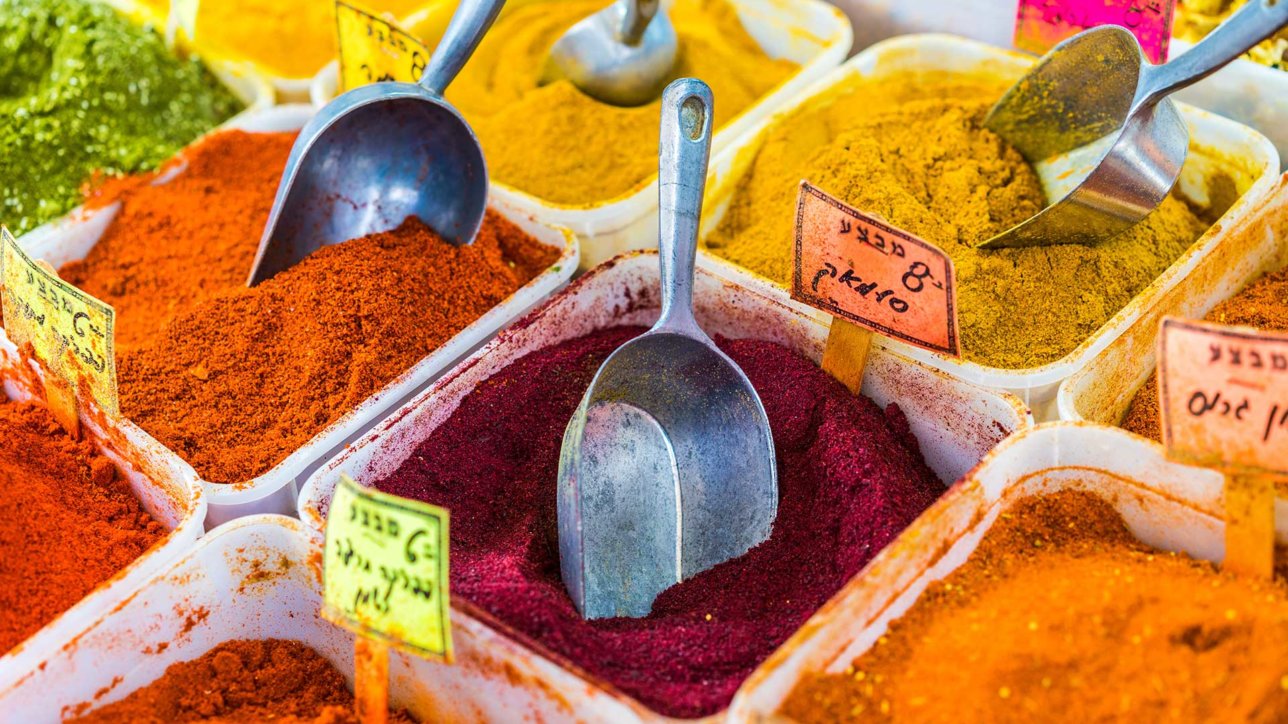The first time we went to Machane Yehuda, Jerusalem’s bustling traditional market, was on our family trip to Israel several years ago. Getting there was a bit of a nightmare back then, even though our hotel was almost within walking distance. As the kids were young we decided to take the bus, which we thought would give a more authentic experience than a cab, and perhaps in a way it did. Nobody thought it worthy to mention to us that the lite railway project (which had apparently been going on since King Solomon’s day) turned what should have been short bus rides into epic journeys. When we eventually got off the bus, older, but not really much wiser, the market was indeed “as advertised” – a colorful bustling traditional “shuk” with rows of vegetables, interspaced with occasional meat, fish, clothing and hardware stalls. Spices piled high in hessian bags delighted my kids who sniffed and sneezed over everything. A gentleman in a cardboard crown informed us he was the King of Halva as he gave us a taste of his wonderful product, which did confirm his royal status, in our minds at least. Jerusalemites shop at the shuk and it’s a great place to get a feel for the ethnic & cultural diversity of this ancient/modern city – old ladies pushed past us with their shopping bags on wheels which doubled as battering rams; Ultra-Orthodox men (trying hard not to notice my wife) mingled with Israeli Arabs, school kids & young soldiers taking a short cut through the shuk – Machane Yehuda is a microcosm of Israeli society and like Israel in general, it’s a crazy wonderful place!
My 9 year old son loved the shouting store holders who yelled prices at each other – apparently there was a strawberry price war the day we went – They’d yell “Chamaish Shekel” (5 shekels) and he’d yell back “One Dollar” in as loud a voice as his squeaky soprano vocal chords could muster – I think the merchants were generally impressed by his squeals and he gathered quite a few samples to taste. Sadly at that time nothing went in his mouth that wasn’t on his very short approved list! We found that if we lingered to peer at a dried fruit display or rack of alien looking fruits, the vendor seemed to accept this as a firm guarantee of a sale. Eventually we exited the shuk with the addition of a bag of dried figs, a huge container of mixed candy, and a metal “Chamsa” key chain a merchant assured us would bring luck. As this was lost somewhere in our hotel within a day, I’m not sure it lived up to the hype!
When we returned to Israel last summer, we knew we also had to return to Machane Yehuda – if only because my son’s voice has long since deepened into a satisfying bass and he was itching to yell at the merchants again. Things have certainly changed: for one thing the lite rail is finally finished thanks apparently to a new mayor since our last visit. We hopped on this efficient, clean transport system, which whipped us through the newly pedestrianized & revitalized Jerusalem center and onto the Shuk in minutes.
As we’d already sampled Machane Yehuda’s atmosphere on our original visit, we’d aimed for a deeper experience this time and we’d spoken to our tour company (Ultimate Israel) in advance about a personal tour of Machane Yehuda. It turned out to be a great idea, and one we’d recommend to all shuk tourists! Our guide seemed to be closely related to most of the stall holders, who greeted him with yelling and puffs of cigarette smoke which we took to be a bonding custom similar to Native American peace pipes. It did seem harder after being introduced by our guide to refuse the many offers of fruit and vegetables, and we quickly learned that “no” means “probably yes” unless you are really firm. That said we still ended our shuk experience heavily laden with fruits and spices we had absolutely no need for, not to mention a new “Chamsa” key ring the hawker assured us would bring “parnasa” (livelihood), but as the shuk visit left us considerably poorer in money (although richer in produce), I’m not sure that this new charm worked any better than the original.
Having a guide opens up the history of the place and the many cultures that live, work and shop in Machane Yehuda – he took us to a quiet corner inhabited by elderly Moroccan Jews intently playing backgammon games, which reminded me of the old Chinese men in San Francisco parks playing Chinese checkers. He pointed out unusual wares for sale, and told us which vendors offered the best deals, and even some tips on getting the best for less.
After our tour we went to a covered street in the market that has been gentrified over the last few years, and is today more tiny café’s, street food and Jewelers than vegetables. There you can feast on delicious and inexpensive pasta served in Chinese take away boxes, or perfect Fish & Chips that even an Englishman would respect. We found a Tapas bar, and burger stand as well as mini coffee shops and of course the ubiquitous falafel stands.
Don’t program less than two hours at Machane Yehuda and don’t forget your camera because the place is a photographer’s shmorgas board. I’d also recommend you go there a little hungry, because I can almost guarantee you won’t leave that way. Whatever else you do in Israel, the Shuk is a must!

